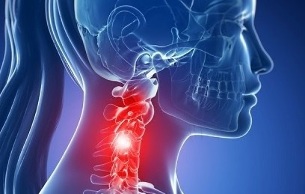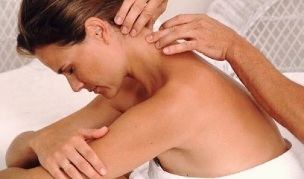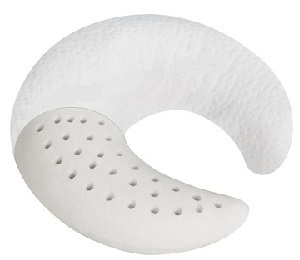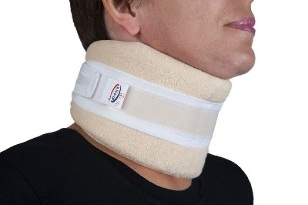
Osteochondrosis is a lesion of the intervertebral discs of a degenerative-dystrophic nature, and the cervical region is the most sensitive part of the spine, with an anatomically different spinal structure and a weak muscular corset. For this reason, even if there are small additional loads on the neck, displacement of the spine can occur, which causes constriction of blood vessels and nerves.
Since the spinal vessels involved in the blood supply to the brain pass through holes in the transverse processes of the spine in this area, pinching the vertebrae in this area or squeezing the holes with increased osteophytes is fraught with very serious consequences.
What is this?
Osteochondrosis of the cervical spine is a polyetiologically progressive disease characterized by degeneration of the intervertebral discs and dystrophy of the spinal cord.
CausesThe main causes and initial conditions of osteochondrosis of the cervical spine are:
- Spinal curvature, scoliosis.
- Stress, nervous tension negatively affects the general condition of the body, can lead to cervical osteochondrosis.
- Past infectious diseases are often rooted.
- Wrong, restless body position during sleep (for example, restless pillow).
- Congenital problems or hereditary diseases of the cervical spine.
- Weak posture in young people and adolescents.
- Overweight, varying degrees of obesity. The extra pounds increase the load on the vertebrae and discs, which leads to degenerative processes.
- Spinal injuries that can occur in childhood or adolescence.
- Disorders of metabolic processes.
- Work related to physical labor, which can cause spinal diseases in various parts.
- Inactive lifestyle, sedentary work, improper exercise.
For successful treatment of cervical osteochondrosis, it is first necessary to identify the cause, the conditions that lead to its development and eliminate them. Until recently, the disease occurred only in people over 45 years. Now young people are exposed to it, the age limit is 18-25 years.
Cervical spine features
Let's look at how the cervical spine differs from the rest of the spine and is a condition for the development of these syndromes during the development of osteochondrosis.
- Important ganglia (nodes) of the autonomic nervous system are located in the cervical region.
- In the transverse processes of the vertebrae, there are holes that form a channel through which the spinal artery passes, supplying oxygen and nutrients to the brain, cerebellum, auditory organs, and also the spinal nerve. These are conditions for frequent constriction of arteries and nerves.
- The cervical spine is the most mobile. It is fully characterized by all kinds of actions. These are often preconditions for violations and subluxations.
- The intervertebral foramen of the lower three vertebrae is triangular, not circular. These are the prerequisites for the compression of nerve roots by bone growths in osteochondrosis.
- The intervertebral discs are not located between the vertebral bodies along their entire length. In the anterior part, instead of them, the vertebrae have protruding edges connected by joints. These are the prerequisites for the occurrence of joint subluxation.
developmental stages
The degree of osteochondrosis is determined by the clinical picture and the patient's complaints. The concept of degree should not be confused with the stages of osteochondrosis. The stages are discussed below.
- First degree. Clinical manifestations are minimal, the patient may complain of low-intensity neck and back pain, which may worsen when dizziness. Physical examination may show low muscle tension in the neck.
- Second degree. The patient is worried about cervical back pain, more intense, there may be radiation to the shoulder, arm. This is due to a decrease in the height of the intervertebral disc and compression of the nerve roots. Painful sensations increase when tilting and turning the head. The patient may experience decreased performance, weakness, headache.
- Third degree. The symptoms of cervical osteochondrosis intensify, and the pain becomes persistent with radiation to the arm or shoulder. As herniated intervertebral discs form, numbness or weakness appears in the arm muscles. Weakness, dizziness are a concern. Examination revealed limited mobility in the cervical spine and pain on palpation of the cervical spine.
- Fourth degree. There is complete destruction of the intervertebral disc and its replacement by connective tissue. Dizziness increases, tinnitus appears, coordination is impaired, as the process involves the spinal artery that feeds the brain and the occipital lobe of the brain.
Symptoms
The severity of cervical osteochondrosis symptoms depends on the degree of destruction of spinal structures. Symptoms are aggravated by osteophytes, radicular syndrome (radicular pain when the nerve is constricted), intervertebral hernia (protrusion of the disc into the spinal canal) and bone growth.
The first signs of the disease are periodic headaches in the occiput, pain in the neck, wheezing and clicks in the vertebrae when turning the head, and sometimes a slight tingling sensation in the shoulders. Over time, the symptoms increase and the intensity of the pain increases.
Pain syndrome is the main manifestation of osteochondrosis. Neck pain is either dull, persistent, or severe with lumbago under the occiput when turning the head. The entire cervical region or the projection area of the altered vertebra, as well as the clavicle, shoulder, scapula, and heart area, may be painful. Radiation of pain in the lower jaw, teeth, arms, ears, eye area is not excluded. The neck and shoulder muscles are tense and painful on palpation. Difficulty in raising the arm from the side of the lesion - immediately there is a lumbago on the shoulder or neck. Restriction of head movements due to pain often occurs in the morning after sleeping in a restless state.
The disease causes compression of the roots of peripheral nerves (radicular syndrome) and causes pain along these nerves. Perhaps the numbness of the hands or fingers is a violation of the sensitivity of some skin areas innervated by a compressed nerve.
Some characteristic symptoms indicate which vertebrae are affected:
- C1 - sensitivity disorder in the occipital region;
- C2 - pain in the occipital and parietal regions;
- C3 - decreased sensitivity and pain in the cervical vertebrae with impaired spinal nerve, impaired sensitivity of the tongue, impaired speech due to loss of control over the tongue;
- C4 - impaired sensitivity and pain in the shoulder-scapular region, decreased tone of the muscles of the head and neck, possible respiratory disorders, liver and heart pain;
- C5 - pain and sensory disturbances on the outer surface of the shoulder;
- C6 - pain extending from the neck to the shoulder blade, forearm, outer surface of the shoulder, radial surface of the forearm to the thumb;
- C7 - pain extending from the neck to the scapula, back of the shoulder, from the forearm to the fingers II - IV of the hand, sensitivity in this area is impaired.
- C8 - pain and sensory disturbances spread from the neck to the shoulder, from the forearm to the little finger.
Cervical osteochondrosis is always accompanied by headaches. Severe, persistent pain, aggravated by dizziness or sudden movements. Some patients complain of heaviness in the head. Compression of the vertebral artery causes dizziness and nausea. There is noise, noise in the ears, black dots vibrate in front of the eyes. Deterioration of cerebral circulation leads to changes in hearing and visual acuity, numbness of the tongue and taste.
Clicks or squeaks during neck movements are accompanied by cervical osteochondrosis, which is observed in almost every patient. A squeak is seen during a sharp turn of the head or throwing back.
Syndromes due to cervical osteochondrosis
Symptoms of cervical osteochondrosis are divided into specific groups called syndromes. Their presence and severity may indicate a pathology of the cervical spine with a certain localization.
A number of common syndromes:
- Vegetative-dystonic syndrome. Subluxation of the first cervical vertebra with displacement can lead to the development of vegetative-vascular dystonia. VSD is not a definite diagnosis because there are no obvious symptoms. There may be neurological signs, symptoms of impaired cerebral blood flow, fluctuations in intracranial pressure, muscle spasms. As a result, the patient's complaints are reduced to dizziness, decreased visual acuity, loss of consciousness, headache, nausea.
- Irritant - reflexive. Burning and sharp pain in the back of the head and neck, sometimes returning to the chest and shoulders, occurs with sneezing and a sharp rotation of the head when there is a change in the position of the head and neck.
- Radical. Otherwise called cervical radiculitis, it combines the symptoms associated with damage to the nerve roots of the cervical vertebrae. "Cold" in the affected area is characterized by tingling in the fingers, arms, mixed skin, spreading to certain fingers.
- Heart. Almost the same picture with angina pectoris often leads to misdiagnosis and treatment. The syndrome is caused by irritation of the phrenic nerve receptors, which partially surround the pericardium and pectoralis major muscle. Thus, spasms in the heart area are more reflexive in response to irritation of the cervical nerves.
- Vertebral artery syndrome. It develops directly with both constriction of the artery and irritation of the sympathetic nerve plexus located around it. The pain in this pathology spreads to the temples, supercoolar arches, and crown in the occipital region, burning or tingling. Occurs on both sides. Patients generally associate exacerbations with lying down, driving, or walking in a non-physiological state. Severe symptoms include hearing loss, dizziness, tinnitus, nausea, vomiting, fainting, and increased blood pressure.
Diagnostics
Like any medical diagnosis, the diagnosis of osteochondrosis is based on patient complaints, medical history, clinical examination, and adjuvant research methods. Cervical spine radiography is performed in the anterior and lateral projections, if necessary, in special positions (open mouth). At the same time, experts are interested in the height of the intervertebral discs, the presence of osteophytes.
Modern research methods use NMR and CT scans, which allow the most accurate diagnosis. In addition to the additional research methods listed, consultation with relevant specialists (cardiologist, ophthalmologist, neurosurgeon) may be required, and examination by a neurologist is simply essential. A neurologist treats osteochondrosis, so after examining the patient, he will determine the minimum required examination at his discretion.
How to treat cervical spine osteochondrosis?
Complex treatment of cervical osteochondrosis can include the following traditional and non-traditional methods: medication, massage, acupressure, manual therapy, physiotherapy, acupuncture, homeopathy, folk remedies, etc.
The basic treatment regimen for osteochondrosis is the same for all localizations of the disease:
- First you need to reduce the pain.
- Then the swelling is removed.
- At this stage it is necessary to normalize blood circulation.
- Strengthening the muscle corset.
- Improving tissue nutrition and regeneration.
The list of drugs and medications for the treatment of cervical osteochondrosis at home is very extensive:
- Anti-inflammatory (steroid). These are hormonal drugs that eliminate inflammation and thus relieve pain;
- Analgesics (non-steroidal analgesics). They are usually prescribed as tablets or capsules. It should be noted that most of these drugs cause irritation of the mucous membranes of the digestive system;
- Muscle relaxants are drugs that relax muscle tone. Used as an adjunct in pain relief in surgery and orthopedics. These drugs are administered parenterally and therefore are always under medical supervision. There is an extensive list of contraindications;
- Chondroprotectors are drugs that replace the components of cartilage tissue. Such drugs must be taken for a very long time to achieve a lasting positive effect;
- Ointments and gels for external use. This is the most accessible group of drugs for home use. They are divided into anti-inflammatory, warming and analgesic. Such funds are often advertised. With cervical osteochondrosis, not all ointments are effective, and due to their presence, they are sometimes used unreasonably and without taking into account the pathogenesis.
- Vitamins. With osteochondrosis, vitamins are prescribed that have a beneficial effect on the peripheral nervous system and improve permeability. Water-soluble vitamins: B1, B6, B12, fat-soluble vitamins: A, C, D, E. In recent years, combined drugs with both analgesic and vitamin components are prescribed more often.

Only a good team of professionals can choose the most appropriate therapy, which includes a neurologist, physiotherapist, massage therapist, surgeon and spinal neurologist.
Physiotherapy
Exercise therapy for cervical osteochondrosis should be performed outside of acute inflammation. The greatest efficiency of this technique is in the recovery period. There should be no discomfort or pain during the performance of the complex!
- Exercise # 1. Lie on your stomach, put your hands on the floor, lift your head and torso, your back should be straight. Stay in this position for 1-2 minutes. Slowly lower to the ground. Repeat 2-3 times.
- Exercise # 2. Lie on your stomach and extend your arms along your body, turn your head to the left, try to touch the ground with your ears, then turn your head to the right. Repeat 6-7 times in each direction.
- Exercise 3. In a sitting position, you should lean forward while breathing and try to touch your chest with your head, then inhale, lean back and turn your head back. Repeat 10-15 times.
- Exercise # 4. While sitting, put your palms on your forehead, press your palms to your forehead, your forehead to your palms. Continue this exercise for 30 seconds. Repeat 2-3 times.
- Exercise number 5. Slowly turn your head first in one direction and then in the other. 10 rotations in each direction. Look at the dizziness. When it appears, the training stops.
Massage Therapy
Massage can be done at home, but very carefully so as not to aggravate or harm the patient. The patient should hold a prone position, place his forehead on his hands and extend his chin towards his chest. The neck muscles should be completely relaxed.
- Stroking. The massage should begin with the following movements: rub the collar area from the lymph to the supraclavicular and axillary nodes. Then straight and comb strokes are applied.
- Pushups. To perform push-ups, the masseur puts his hand on his neck (index and thumb should be together) and moves towards the spine. Push-ups can also be done from the edge of the palm to the shoulder joints.
- Rub. Rubbing is done to warm up, relax the muscles and improve blood flow to the area. The massage should begin at the base of the skull with circular and straight movements with your fingers. You can also perform sawing movements parallel to the palm and ribs.
- Kneading. The neck should be kneaded in a circular motion.
- Vibration. The massage ends with strokes and vibrations, which are performed by shaking and tapping.

Massage is needed to strengthen muscle tone and reduce pain. Depending on the stage of osteochondrosis, massage techniques are chosen. However, experts use all the methods of classical massage when massaging the neck: rubbing, stroking, kneading, etc. In cases where there is pain on only one side of the patient, the massage begins in the healthy part of the neck and gradually moves to the part of the neck where the painful sensations occur.
Manual therapy
Manual therapy helps to cope with both acute and chronic pain, while increasing the level of movement and improving posture. The main methods of manual therapy for cervical spine osteochondrosis:
- Relaxing and segmental massage. Used to relieve muscle warmth and tension.
- Mobilization. Effects on the restoration of joint function by traction.
- Manipulation. A sharp push targeting the patient's pathological areas. The procedure is accompanied by a characteristic crisis (return of the joint to its normal position).
A chiropractor should be familiar with these techniques. Otherwise, any error may result in injury.

Orthopedic pillows
Orthopedic sleeping bags are an effective preventative tool. In many cases, osteochondrosis is aggravated by additional compression of the cervical artery and nerve roots while lying on an uncomfortable pillow. The orthopedic product provides a uniform horizontal position of the person during sleep and thus provides a physiologically adequate blood supply to the brain.
When choosing a pillow, the individual anatomical features of a person should be taken into account and correlated with the volume and characteristics of the filling. A well-chosen pillow brings material benefits to a patient with cervical spine osteochondrosis.
Physiotherapy
Physiotherapy procedures for cervical spine osteochondrosis:
- Electrophoresis. It should be used with analgesics (anesthesia) injected under the skin with electronic pulses.
- Ultrasound. It has a beneficial effect on metabolic processes in the tissues of the cervical spine, so the swelling is eliminated, the pain is relieved.
- Magnetotherapy. A safe treatment that involves damaging damaged cells to a low-frequency magnetic field. Has analgesic effect, acts as an anti-inflammatory agent.
- Laser therapy. Improves blood circulation in the affected area, eliminates tissue swelling and pain.
Physiotherapy procedures have a beneficial effect on the discs and spine in cervical osteochondrosis. In addition to medication, combined treatment helps to get rid of the symptoms of the disease. Procedures are performed in specialized rooms in hospitals or clinics. Before starting the course, you should consult a doctor, determine the duration and types of physiotherapy. It is strictly forbidden to pass during aggravation.

Trench collar
Shants collar is a soft and comfortable device, fastened with Velcro on the back and used for cervical osteochondrosis. But not for treatment, but for temporary relief and relief from fatigue. It cannot be worn without removal, otherwise the neck muscles will stop working and atrophy in a short time. If the shants collar is chosen correctly, the patient feels comfortable and protected.
Thecollar is definitely the size to choose from at a drugstore or orthopedic store. It is better in a store, because the people who work there, as a rule, know their job and the characteristics of the product well enough, which means that they can help in any specific situation.
Folk remedies
If the pain from osteochondrosis of the spine is unbearable and regular, you will agree to do everything to stop it, and here the traditional complex treatment will be successfully completed by alternative methods.
- Insist celery root (5 grams per 1 liter of boiling water) for 4 hours, for one tablespoon before each meal;
- honey compress, for this we take 2 tsp. honey and 1 tablet mummy. We heat the components in a water bath, spread them on a piece of cloth and apply it to the cervical region, ie the neck at night;
- Horseradish growing in the country helps me in case of severe pain. I just wash its leaves, pour hot water over it, cool it a bit, apply it around my neck and wrap it in a thin scarf for the night - you can live and work anyway in the morning;
- Insist chamomile flowers in vegetable oil for two days, heat to a boil (30 grams of herbs are needed for 500 ml of oil), rub on the wounds;
- honey-potato compressor also helps, for this you need to rub the same amount of root and mix it with honey, apply to a sore throat at night, use it regularly once a week.
Prevention
As always, proper prevention will help avoid cervical osteochondrosis, but of course all physical exercise should be used regularly, otherwise "periodic" exercise will be of little use.
Simple rules to remember:
- Eat foods rich in calcium and magnesium. These include fish, peas, legumes, nuts, cheese, and herbs, but it's best to avoid sugar, flour, smoked, and spicy foods. Gymnastics is also suitable for the prevention of osteochondrosis, which can be applied at home.
- Perform a set of special exercises at least twice a day in a sitting position.
- Choose a good orthopedic mattress and an ideal pillow for your neck that keeps your head in the correct anatomical position during sleep (yes, your favorite giant low pillows don't end with spinal problems! )
If you have such a diagnosis, the patient should spare the spine, ie:
- Be very careful when lifting and carrying, it's better to go to the store twice than to carry heavy bags in both hands and put incredible strain on your neck and shoulder girdle;
- Don't get too cold, avoid drafts and cold air from the air conditioner (some people want to cool off on a hot day, leaning their backs on a fan);
- When bending the trunk forward - do not forget about osteochondrosis;
- Avoid local muscle overheating, which can occur in extremely hot baths;
- Remember to leave the monitoring from time to time, change your body position, do not sit for hours or even days;
- Relax your neck by taking the Shants collar;
- If possible, take a steam bath if the condition of the cardiovascular system allows.
In conclusion, I would like to say that a child at risk of osteochondrosis (father and mother already have it) and an adult who died during the disease are simply obliged to take preventive measures to avoid disability and fall on the operating table, because this operation is quite complex and time consuming. requires rehabilitation. In addition, it is not always possible, because there are cases where it will not work, so it is better to protect your health from a young age, if the discs are intact and unnecessary growths do not constrict the blood vessels.





































